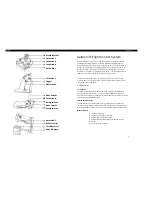
WPC 1000 User Manual
1125100
Extracts from OSHA and ANSI
A-7
Extracts from ANSI B11.1-2009 8.6.3
Standards Requirements
Explanatory Information
8.6.3 Presence-sensing safeguarding device
8.6.3.1 A presence-sensing device, when used
for safeguarding, shall protect the operator as
specified in E8.6.1 (a).
E8.6.3.1 Various presence-sensing devices
employ different sensing and adjustment
techniques. The point at which a device
responds to an intrusion can vary.
Safety mats and area scanners may not be
suitable (effective) safeguards when utilized as
primary point-of-operation safeguarding.
Factors which can affect this suitability include
but are not limited to:
a) response time;
b) minimum object sensitivity;
c) measurement accuracy;
d) breach ability;
e) penetration before detection;
f) single point of failure;
g) large safety distances.
These devices may be utilized as supplemental
safeguarding.
8.6.3.2 The device shall be interfaced with the
control circuit to prevent or stop slide motion if
any object is within the sensing field of the
device during the hazardous portion of the
cycle.
E8.6.3.2 The device should be located or
adjusted so that the device always responds to
the intrusion at or prior to the safety distance Ds.
Also, care should be taken when installing the
device so that it does not detect false signals
from other devices or equipment in the area.
The presence-sensing device cannot protect
against a catastrophic failure of the press, which
causes unintended cycling action. See Annex A,
Figure A.3.
8.6.3.3 The device shall not be used for
safeguarding the point-of-operation on presses
using full-revolution clutches.
8.6.3.4 When the sensing field has been
interrupted, use of the normal press cycle-
actuating means shall be required after clearing
the sensing field to resume press operation.
8.6.3.5 When the device is used in the PSDI
mode, re-initiation of the press motion shall be in
accordance with 6.4.3.8.1.
8.6.3.6 Muting of the device shall be permitted
only during the non-hazardous portion of the
press cycle.
E8.6.3.6 Muting is typically accomplished by
interface circuits or auxiliary controls.
The die closing portion of the cycle is always
considered hazardous. In some cases, feeding
and transfer automation or die features can
cause additional hazardous conditions even
during the opening portion of the cycle
(upstroke). See also ANSI B11.19 for additional
information.
Summary of Contents for WPC 1000
Page 17: ...1125100 WPC 1000 User Manual xii Table of Contents ...
Page 99: ...1125100 WPC 1000 User Manual 2 72 Installation ...
Page 207: ...1125100 WPC 1000 User Manual A 18 Extracts from OSHA and ANSI ...
Page 217: ...1125100 WPC 1000 User Manual G 6 Glossary ...
Page 223: ......
Page 224: ......
Page 225: ......
Page 226: ......
Page 227: ......
Page 228: ......
Page 229: ......
Page 230: ......
Page 231: ......
Page 232: ......
Page 233: ......
Page 234: ......
Page 235: ......
















































